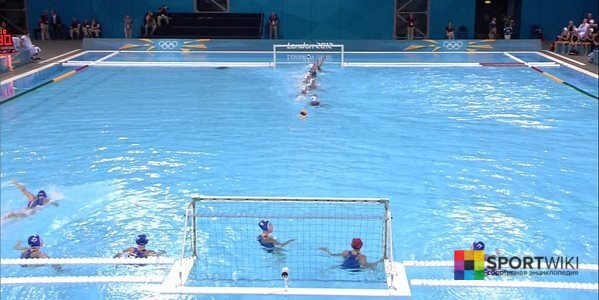Water polo
Water polo is a team water sport, in which the main purpose of the game is to put more balls into the gates than the opposing team at the scheduled time. The game takes place in the water, and the ball is held and scored into the gates with one hand.
The International Swimming Federation (fr. Federation Internationale de Natation, FINA) is the organization that unites the majority of national swimming federations. The headquarters is located in Lausanne (Switzerland).

History of water polo
The Japanese game in which the players tried to hand off the ball to the players of their team with special poles while being afloat on straw barrels can be considered the progenitor of water polo.
Modern water polo was invented in the second half of the 19th century by William Wilson. At first, the game was very much like rugby, because the first edition of the rules allowed to use force in the fight for the ball and hold the opponent. In addition, the water polo field was marked on still water, and instead of the gates, there were sticks dug in the bottom of the reservoir, protruding 30-40 cm above the surface of the water. Players had to swim the ball into the gates.
In 1869, water polo was presented to the general public in London for the first time. In those days the game was called “football on the water” and did not have clearly defined rules. In 1870, a commission of sports experts was convened to formalize the rules, but the commission did not achieve any results. Only in 1876, William Wilson laid down the rules of the water polo game, which remained relevant until 1890.

Since 1900, the game is included in the list of Olympic sports, and the first world water polo championship was held in 1973.
Rules of Water Polo
The water polo match consists of four quarters respectively, 8 minutes each. The countdown in the quarter begins with the first touch of the ball.
Each team has only 25 seconds to attack and after 25 seconds the ball passes to the opposing team. The rules allow each team to take 4 time-outs per game at a regular time and 1 time-out per game at extra time. Only the team that owns the ball can ask for the time-out.

There can be 6 field players and 1 goalkeeper on the field at the same time.
The rules of water polo do not allow:
- to attack a player who isn’t owning a ball;
- to heat, drag and hold a player who isn’t owning a ball;
- to heat a ball.
Having made a gross blunder, the player leaves from water for 15 seconds or until the end of the opponent's attack time. At the end of the penalty time, the player must return to the game. A non-gross blunder is punished by a free throw, which can be sent directly to the gates of the opponent. The player who has earned 3 penalties leaves till the end of the game with the right of replacement and sits on the sub bench with the pool hat untied.
Field of play
The size of the playing field for men is 30 x 20 meters, for women 25 x 17 meters. The depth must be at least 1.8 meters. The field needs the following marking:
- midfield line (white);
- gate lines (white);
- 2-, 4-, 7-meter lines (red, yellow, green);
- the boundary of the playing field.
The marking should be clearly visible throughout the game. The marking can be permanent or removable. At the end of the playing field, two meters from the corner of the playing field (opposite the official scoreboard), a red or other bright color sign must be affixed.

Gates are set on both sides of the playing field. The gate consists of two uprights and a rectangular crossbar of 0.075 m thickness, facing the playing field and painted white. It must be set strictly in the middle of the gate line and at a distance of at least 0.30 m from the borders of the playing field. The distance between the gate uprights should be 3 m, and the lower edge of the crossbar should be at a height of 0.90 m above the water surface. The minimum water temperature is 16 degrees.
Outfit and equipment for water polo
The ball for water polo has a round shape and an air chamber with a closing nipple. The weight of the ball has to be ranging from 400 to 450 grams. The circumference of the ball for games of the men's teams is 0.68 — 0.71 meters, and for games of the women's teams is 0.65 — 0.67 meters.

Cap with ear protectors protects players from powerful ball strikes. Hats are fastened under the chin and not removed until the end of the game. Usually one of the teams plays in white hats, and the other is in blue ones. Hats of goalkeepers are painted red.

Standard Provisions
A corner kick is awarded if a player knocks the ball over his own gate line or the ball touched that player last before leaving the gate line. A corner kick is performed by a player of the opposing team from a two-meter line.
A held-ball is appointed if the judge cannot determine which of the players has violated the rules first. When playing a held-ball, the players of both teams must be at the same distance from the place where the rules have been violated, and that is where the judge will throw the ball. As soon as the ball touches the water, players will be able to touch the ball.
Judging
The panel of judges consists of the chief judge, the scorekeeper, and the judges at the gate. The chief judge has an unlimited right to vote in matters related to the scoring of a goal, corner throws, goal-throws, as well as violations of the rules.

The scorekeeper controls leaving the field.
The judges at the gate are located on the sides of the pool at the level of the gate line. They give the following signals flags:
- a white flag on the “offside” position,
- a red flag — about the execution of a corner ball,
- flags of both colors — about scoring the goal.
Water polo competitions
The Olympic Games are the most prestigious water polo competitions.
The World Water Polo Championships is the competition of national teams, which takes place within the second most prestigious World Aquatics Championships.

